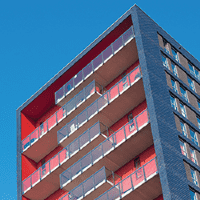■ The under-served middle tier: developers expanding into new territories typically target the ‘low-hanging-fruit’ of the upper market segment. This leaves the middle tier, between lower-quality university stock and the new, premium product, unserved. Partnerships with universities or social providers to upgrade existing properties may be a means to serve the middle tier.
■ Complementing the student model: the co-living model mixes students with other occupiers. This broadens the demand base as well as supporting a wider range of services and amenities, in turn enhancing the appeal to occupiers. Examples include the Collective in the UK, and The Fizz in Germany. We expect this model to expand, particularly in major cities that see demand from young professionals as well as students (where planning permits).
■ Study abroad, but close to home: as the globally mobile student population deepens beyond the most affluent, there is a growing trend to study abroad, but close to home. International student numbers in the UAE grew 15% in 2015, while numbers have increased 462% in Saudi Arabia in the last decade. Regional hubs will continue to grow in importance, particularly those which host branch campuses of established institutions.
■ Diversification and growth: we expect to see more diversification of portfolios to include both residential and PBSA. Investment growth will continue as pioneers sell and recapitalise, fuelling investment activity with more trading stock.
■ Responding to the skill-shift: 65% of children entering primary school today will end up working in job that doesn’t yet exist. The most successful institutions will be those that can innovate to meet the changing needs of the workforce. There has been a shift to STEM subjects in recent years, but a premium may yet be placed on creative skills to balance the rise of automation in the workplace. Real estate investors would do well to watch for universities that are ‘rising stars’ and teaching the courses that the new workforce wants.




